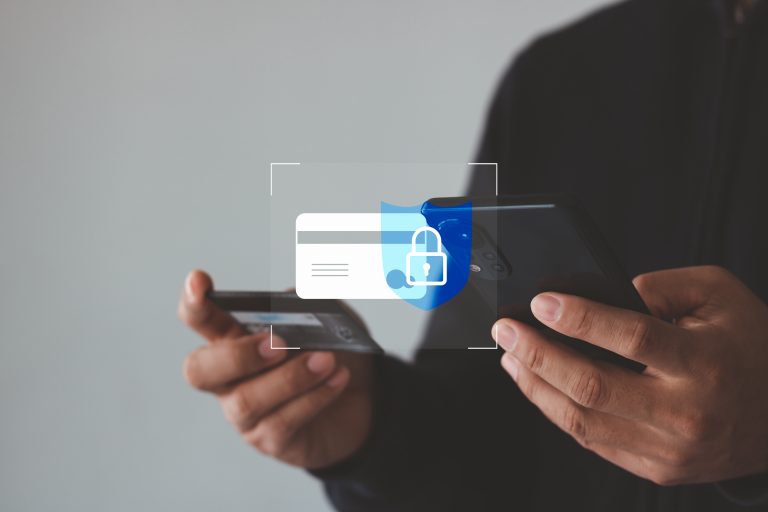Biometric Identification in Banking: The Future of Secure Transactions
January 30, 2024In an age where digital security is of utmost importance, biometric identification has emerged as a pioneering technology in the…

In an age where digital security is of utmost importance, biometric identification has emerged as a pioneering technology in the banking industry. But what exactly is biometric identification and how does it work? From facial and fingerprint recognition to voice and DNA recognition, the types of biometric identification are diverse and sophisticated.
Biometric identification uses unique biological or behavioral traits, such as fingerprints, facial features, iris scans, and voice patterns, to securely verify an individual’s identity through advanced technology. It finds key applications in customer authentication, enhancing security for online transactions and access to private information. Advances in AI, exemplified by systems like Onfido, make biometric identification more sophisticated by incorporating machine learning to improve accuracy, speed, and adaptability. This technology is increasingly valuable across industries, from finance to healthcare.
Biometric identification operates by capturing and analyzing distinct biological or behavioral traits of individuals, such as facial features, fingerprints, or iris patterns, and translating them into digital identifiers through advanced technology.
Biometric identification encompasses various types, including fingerprint recognition, facial recognition, iris recognition, voice recognition, hand geometry recognition, retina recognition, signature recognition, and DNA recognition, each offering distinct methods for verifying individual identities.
Fingerprint recognition is a prevalent biometric identification method that relies on capturing and analyzing the unique patterns present in an individual’s fingertips, serving as a highly accurate and secure form of identity verification.
By leveraging advanced algorithms, fingerprint recognition systems can precisely map and digitize the intricate ridge patterns and minutiae points on an individual’s fingerprints. This data is then stored and compared to verify a person’s identity, offering a seamless and quick authentication process.
With its widespread applications in mobile devices, access control systems, and law enforcement, fingerprint recognition has revolutionized biometric security measures, providing a level of security and convenience that traditional methods cannot match. Its uniqueness and resistance to forgery make it a highly reliable form of authentication.
Facial recognition involves the analysis of unique facial features to authenticate an individual’s identity, utilizing advanced, biometric sensor technology and AI-driven solutions like Onfido to enhance accuracy and security.
Biometric authentication in facial recognition has become increasingly reliable, harnessing the distinct patterns of a person’s facial structure, such as the distance between the eyes, nose, and mouth.
Onfido, as a prime example of AI integration, employs machine learning algorithms to continuously refine its recognition capabilities, making it adept at discerning real faces from printed images or disguised attempts.
The synergy between biometric technology and AI has led to the development of robust anti-spoofing measures, mitigating vulnerabilities to facial impersonation or tampering. This innovation is pivotal in fortifying digital identity verification processes, especially in sensitive sectors like finance, healthcare, and border security.
Iris recognition leverages the distinct patterns within an individual’s iris to establish a highly secure and reliable form of biometric identification, offering advanced technological solutions for identity authentication and security.
Iris recognition operates by capturing high-resolution images of the iris. This is typically done using specialized cameras equipped with near-infrared illumination, which enhances the visibility of intricate iris patterns.
After capturing the image, the unique features of the iris, such as crypts, furrows, and freckles, are extracted and encoded into mathematical templates. These templates are then securely stored and used for comparison during subsequent recognition attempts.
One of the key benefits of iris recognition is its extremely low false acceptance and rejection rates. This makes it highly reliable for various applications such as access control, time and attendance tracking, and security screening across different sectors.
Voice recognition utilizes individual vocal patterns and characteristics to verify a person’s identity, offering a convenient and efficient biometric identification method with applications in customer authentication and advanced AI technology.
This technology has advanced significantly in recent years, employing machine learning algorithms to dynamically adapt to variations in speech patterns and accents.
In the context of biometric identification, voice recognition adds another layer of security, as it is unique to each individual and difficult to replicate.
Its integration with AI systems enables enhanced personalization and interactive experiences, as seen in virtual assistants and voice-activated devices.
Hand geometry recognition involves analyzing the unique physical attributes of an individual’s hand for identity verification, offering enhanced security measures and technological applications in biometric identification.
This technology captures the dimensions of an individual’s hand, including finger length, width, and knuckle shape, creating a unique profile that can be matched for secure access.
Unlike other biometric systems, hand geometry recognition is non-intrusive and does not require physical contact, making it more hygienic and user-friendly.
Its applications span across various industries, from access control in high-security facilities to time and attendance tracking in workplaces.
The use of hand geometry recognition enhances overall security measures by providing a reliable and accurate means of identity verification through physiological characteristics, minimizing the risk of unauthorized access.
Retina recognition utilizes the distinct patterns present in an individual’s retina to provide a highly secure and reliable form of biometric identification, offering advanced technological solutions for identity authentication and security.
This technology captures the unique patterns of blood vessels within the retina, which remain stable throughout an individual’s lifetime, making it an incredibly accurate form of biometric identification.
The sophisticated algorithms used in retina recognition systems analyze these patterns, creating a highly secure authentication method for of verifying a person’s identity. This approach not only enhances security measures but also provides convenience by eliminating the need for traditional authentication methods such as passwords or ID cards.
The implementation of retina recognition in various industries, including banking, healthcare, and government, has significantly bolstered security protocols and safeguarded sensitive information.
Signature recognition involves analyzing and verifying an individual’s unique signature as a form of biometric identification, offering applications in customer authentication and secure transaction verification processes.
Signature recognition is a biometric identification method that captures and analyzes dynamic characteristics of a person’s signature, such as pen pressure, stroke speed, and direction. This data is used to create a unique digital representation of the signature, providing a reliable means of authenticating individuals. In customer authentication, this technology is particularly useful for businesses in sectors like banking, finance, and legal documentation. It plays a crucial role in preventing fraud and unauthorized access, enhancing overall security in transaction verification processes.
DNA recognition involves using an individual’s unique genetic code for biometric identification, offering unparalleled levels of security and authentication through advanced technological applications.
This cutting-edge technology harnesses the distinctive patterns within an individual’s DNA to create highly secure authentication mechanisms. Leveraging DNA sequences as a means of identity verification, provides an incredibly robust and tamper-resistant form of security.
Advancements in DNA-based authentication have revolutionized the field of biometrics, enabling seamless and accurate recognition of individuals. The utilization of bioinformatics and powerful algorithms has enhanced the precision and reliability of DNA recognition systems, ensuring foolproof identification. As a result, DNA recognition is being increasingly integrated into various sectors, including law enforcement, healthcare, and access control, for its unparalleled level of authentication and security purposes.
Biometric identification brings significant advantages to the banking sector, offering increased security, enhanced convenience, improved customer experience, and cost savings. Adopting biometric methods like fingerprint, iris, or facial recognition enhances bank account access security, reducing the risk of unauthorized access and identity theft. This technology streamlines Know Your Customer (KYC) processes, facilitating identity verification for compliance while ensuring a smoother customer experience. By minimizing reliance on vulnerable methods like PINs and passwords, biometric identification reduces instances of fraud and unauthorized access, leading to substantial cost savings for banks.
Biometric identification in banking significantly enhances security measures, offering robust authentication processes that reduce the risk of fraud, unauthorized access, and digital threats, ensuring a safer banking environment for customers and financial institutions.
Biometric identification not only provides a secure and convenient way for customers to access their bank accounts but also significantly reduces instances of identity theft and fraudulent activities.
By utilizing unique physical characteristics such as fingerprints, iris patterns, or facial recognition, banks can ensure that only authorized individuals can access sensitive financial information, greatly mitigating the risk of unauthorized transactions or breaches.
The integration of biometric technology enables a seamless and efficient authentication process, eliminating the need for cumbersome and potentially vulnerable methods like passwords or PIN codes.
This not only enhances the overall customer experience but also strengthens the security posture of banking systems, making it far more challenging for cybercriminals to gain illicit access to accounts or compromise sensitive data.
Biometric identification technology in banking provides enhanced convenience for customers, streamlining authentication processes and enabling seamless access to financial services, ultimately improving the overall customer experience.
One of the key advantages of biometric identification in banking is its ability to simplify the authentication process. With the use of biometric data such as fingerprints, facial recognition, or iris scans, banking customers can quickly and securely verify their identities without the need for traditional methods like PINs or passwords.
This not only saves time for customers but also enhances security by significantly reducing the risk of unauthorized access. Biometric authentication seamlessly integrates with various banking services, from account access to transactions, offering a unified and convenient user experience.
Biometric identification technology in banking contributes to an improved customer experience by offering efficient and secure authentication processes, aligning with the evolving digital default standards, and leveraging advanced AI solutions such as Onfido for customer-centric innovations.
The implementation of biometric identification not only streamlines the authentication process for customers but also enhances the security of their financial information.
By utilizing Onfido and similar AI-powered systems, banks can offer seamless and reliable services to their customers, creating a sense of trust and confidence in the digital banking environment.
The integration of biometric technology into digital payments allows for greater personalization of customer experiences, as users can access their accounts and perform transactions with ease, boosting satisfaction and loyalty.
Biometric identification translates into cost savings for banks through streamlined authentication processes, reduced fraud-related expenses, and enhanced transaction security, contributing to overall financial efficiency and risk management.
The implementation of biometric identification and biometric payment systems in banking operations has proven to be a strategic move for mitigating financial risks and enhancing security measures. By incorporating advanced biometric technology such as fingerprint recognition and facial recognition, banks can significantly reduce the incidence of fraudulent activities, thereby curbing the associated expenses related to fraud investigation, litigation, and customer compensation.
The utilization of biometric authentication not only strengthens transaction security but also fosters a seamless customer experience, thereby retaining customer loyalty and trust. The reduction in fraudulent activities and unauthorized access through these biometric verification methods results in substantial cost savings for banks, ultimately bolstering the overall financial efficiency and risk management within the banking sector.
While biometric identification offers advantages in banking, concerns arise regarding privacy, identity theft, and implementation challenges. Privacy risks stem from collecting and storing personal biometric data, raising worries about unauthorized access and misuse. Implementation challenges involve creating secure systems to manage and move biometric banking transactions and authenticate biometric data seamlessly within existing banking infrastructure. To mitigate the risk of identity theft through biometric data breaches, stringent security measures and continuous technological advancements are necessary to stay ahead of cyber threats.
Privacy concerns arise in biometric identification within the banking sector due to the sensitive nature of personal biometric data, necessitating stringent security protocols and transparent data handling practices to mitigate potential privacy risks and safeguard customer trust.
The utilization of biometric identification technologies, such as fingerprint and facial recognition, in banking operations demands a high level of confidentiality and protection.
An integral aspect of addressing these concerns involves implementing encryption methods to secure biometric templates and ensuring compliance with stringent regulatory standards.
Furthermore, biometric data handling practices should prioritize informed consent, secure storage, and restricted access, providing customers with assurance about the privacy and security of their sensitive information within the banking domain.
The potential for identity theft poses a challenge in biometric identification within banking, necessitating advanced fraud detection measures, secure data storage, and continuous technological advancements to mitigate the risks of identity fraud and unauthorized biometric data usage.
Biometric identification in banking offers a promising solution for security and authentication, but it’s not without its vulnerabilities. One of the primary challenges is the risk of unauthorized individuals gaining access to biometric data and using it for identity theft.
Sophisticated fraud detection measures are essential to detect and prevent such unauthorized access. Secure data storage is crucial to safeguard the biometric information of customers from potential breaches.
Continuous technological advancements are also vital in staying ahead of cybercriminals who may attempt to exploit these biometric payment systems. As biometric technology evolves, so do the tactics employed by fraudsters. Therefore, ongoing advancements in biometric authentication and data protection are essential to ensure the integrity and security of the banking sector.
The implementation of biometric identification in banking presents challenges related to technology integration, user acceptance, and regulatory compliance, requiring comprehensive strategies and collaborative efforts to ensure seamless adoption and operational success.
Developing a robust technology infrastructure that can efficiently handle biometric data, work together with existing banking systems, and ensure the security and privacy of customer information is a significant challenge. Gaining customer acceptance and trust in the reliability and security of biometric identification methods is pivotal for successful implementation.
The need to align with stringent regulations concerning data protection, identity verification, and privacy further complicates the adoption process. Coordinating efforts among various stakeholders including banking institutions, technology providers, regulatory bodies, and industry experts is essential for creating and implementing comprehensive strategies that address these challenges.
Collaboration is key to developing solutions that not only meet the technical and compliance requirements but also prioritize user experience and security.
The future of biometric identification in banking involves expansion to other industries, integration with technologies like AI and blockchain, and continuous advancements for enhanced security and user access. This evolution is set to revolutionize sectors like healthcare, retail, and travel, providing secure and convenient access to personal data and services. The integration of biometrics in banking along with cutting-edge technologies enhances authentication methods for the digital age, with ongoing improvements in algorithms and sensors expected to boost accuracy and reliability, ensuring unparalleled security and customer experience across diverse industries.
The expansion of biometric identification beyond banking highlights its adoption across industries for advanced security, convenient user access, and AI-driven solutions. Widely used in healthcare, retail, and transportation, biometrics enhances security measures, reducing the risk of unauthorized access and identity theft. Its seamless user experience, replacing traditional methods with fingerprint or facial recognition, improves accessibility and simplifies authentication. The integration of AI with biometrics enhances accuracy and fraud detection, revolutionizing biometric identity verification for secure authentication experiences in various sectors.
The integration of biometric identification in banking, including fingerprint and facial recognition, enhances customer experience and security protocols. When biometric payment cards are combined with technologies like mobile banking apps and IoT devices, it streamlines user transactions. The synergy of biometrics with AI enables advanced fraud detection, ensuring a secure and convenient banking experience. This convergence sets the stage for future innovations in authentication within the banking sector.
Continuous advancements in biometric identification technology in online banking also signal a commitment to refining security and optimizing user experiences. Integration with AI-driven innovations allows for advanced authentication methods, creating a secure and frictionless environment. Biometric features like fingerprint, facial recognition, and voice authentication enhance security and personalize the customer experience, ensuring robust and reliable transactions. This fosters customer confidence in digital banking.

In an age where digital security is of utmost importance, biometric identification has emerged as a pioneering technology in the…

Ripoff Report removal can be very beneficial to a business owner or company that is currently dealing with a report…

Learn how reputation management can help you take control of your digital footprint. Today, your reputation online is more…